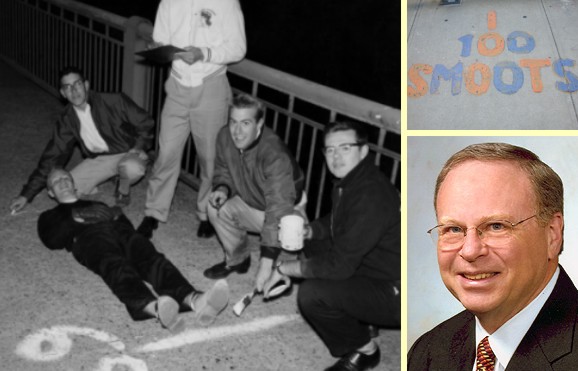Kansas Snapshots by Gloria Freeland - April 19, 2013
Smoot sailing
Growing up in Kansas - a state that once called itself "Mid-way USA" - I was moderately insulated from many influences of
the outside world. But when the space program hit its stride, and math and science were elevated in importance,
like many, I began to bump into the foreign metric system. The rapid conversion urged by some failed, but little by little,
even those of us in distant Kansas have accepted some changes such as buying soft drinks by the liter.
By this point in my life, I think I have a pretty good feel for the English units we use daily. I have an intuitive
understanding for how long an inch, foot, yard and mile are and how much I'm getting when I buy a pound of meat or a gallon
of milk. I also know more or less when an hour has passed - although the hours do seem to pass more quickly now than
when I was younger.
Somewhere back in school, I was taught the origins of many of these units. What I recall most clearly is that many seemed
at first to be arbitrarily defined. One popular notion was that a yard was the distance between the tip of the nose and the
end of the thumb of England's Henry I. A foot may have once been determined by the average length of a shoe-covered male foot.
Most units used today have been standardized, but at least one pretty important one is not standardized at all. It's hard to
locate anyone who isn't interested in money. Yet despite much energy devoted to making dollar bills and metal coins, we have no
stable notion of what they are worth in terms of what matters most to us - such as how much food or clothing can be purchased
with a given amount of the stuff. In 1953, the year I was born, a person could live quite comfortably on $5,000 per year, but
today he or she would need at least 10 times that amount to live to the same standard.
I encountered an unfamiliar measurement a few years ago when husband Art and I were working on deeds related to family
property. Old survey maps were often measured using a surveyor's chain. Each chain was 66 feet long and was made up of 100
links. Each link was 0.666 of a foot...or 7.92 inches. There are 10 chains in a furlong, and 80 chains in one statute mile.
An acre is the area of 10 square chains. That was when I learned where the acre - something I was very familiar with, having
grown up on a farm - came from.
A few days ago, Art introduced me to another completely unfamiliar unit of length ... the smoot or Smoot. Art, an engineer,
had only a vague recollection of hearing about it before a recent chance encounter while searching the Internet for some
information about mapping.
Historically, the names of units were rather descriptive. The word inch was derived from "uncia," the Latin word for 1/12
and so that fraction of a foot was called an inch. Because the Babylonians liked to use the sexagesimal (1/60) rather than
the decimal (1/10) system, they divided the hour by 60 to yield minutes and then by 60 a SECond time to produce seconds.
But now it is common to use units named after people and that is the case with this latter unit. It was named for Oliver R.
Smoot, a 1958 student at the Massachusetts Institute of Technology. In this instance, it is a very personal unit for Mr.
Smoot as it is the distance from the top of his head to the bottom of his feet.
Recognizing the arbitrary nature of units, his Lambda Chi Alpha fraternity brothers decided to define a new unit of length
and prospective inductee Smoot's height was chosen as its base length.
But having a unit is only meaningful if you measure something with it and so the decision was made to measure the length of
the bridge that connected Cambridge with Boston. This was accomplished by having Smoot lie on the bridge while his buddies marked
where the top of his head lay. Then they picked him up and moved him along the bridge, setting him down with his feet at the
prior location of his head. In this manner, measuring the bridge was smooth sailing - or would that be Smoot sailing? They
discovered the bridge was a bit more than 364 Smoots in length.
While this was done as just a fun exercise, it has lived on in several ways. For one, when the bridge was to be renovated,
the police asked that the Smoot marks be preserved as they found them useful in documenting the location of accidents. The
concrete of the reconditioned bridge was inscribed with Smoot marks.
The Smoot also lives on at Google where users of the Google Earth software application can choose the smoot as their
base length unit.
In case you'd like to use this new unit in your own life, one Smoot is equal to 67 inches.
Oh, and Mr. Smoot? Well, maybe the fraternity exercise was professionally predictive. He went on to become the chairman of
the American National Standards Institute (ANSI) and president of the International Organization for Standardization (ISO).
Smoot sailing, indeed!
